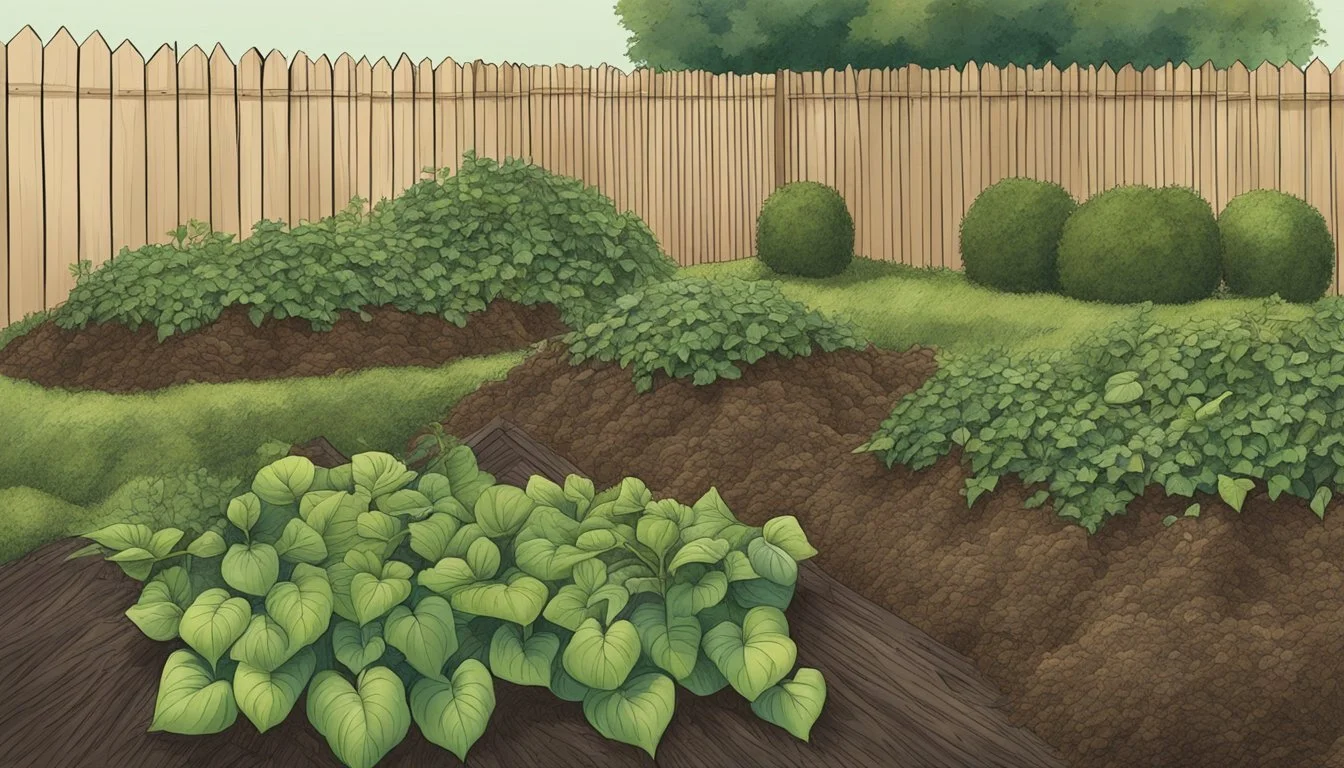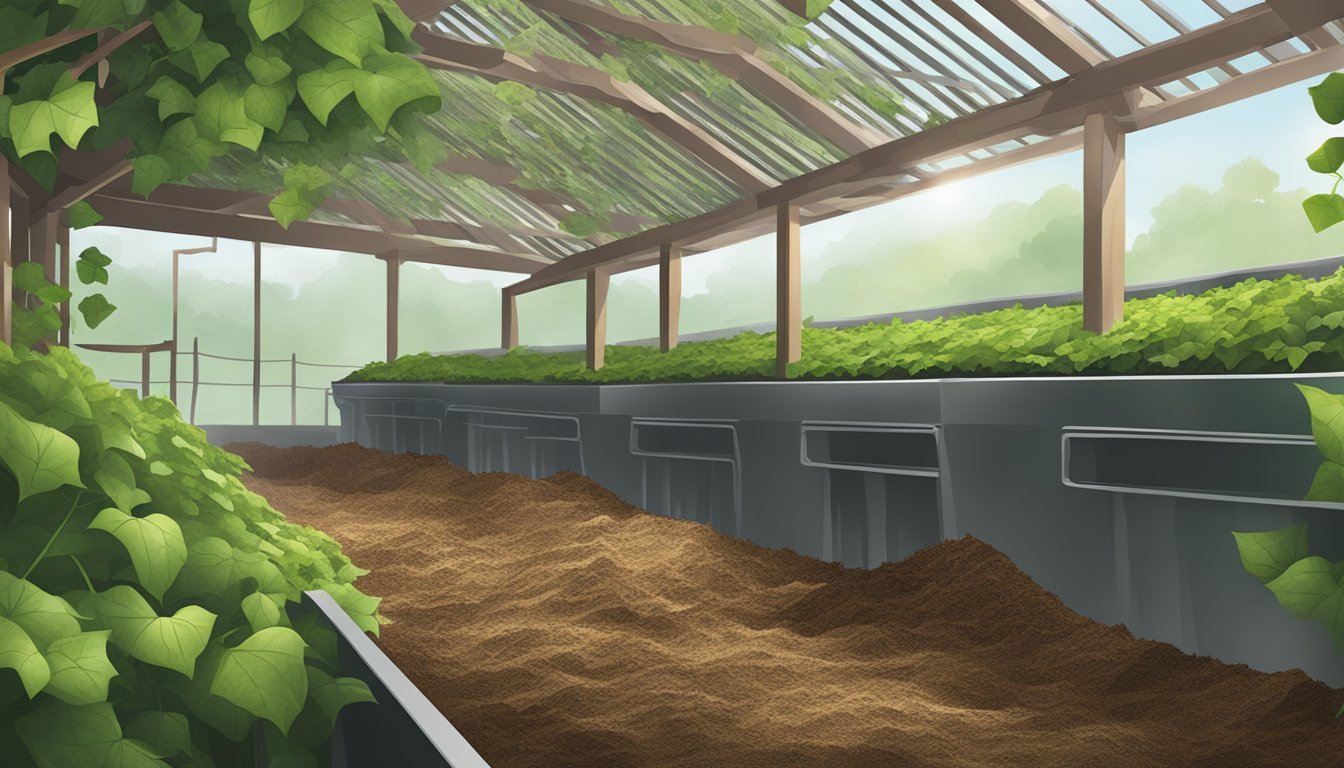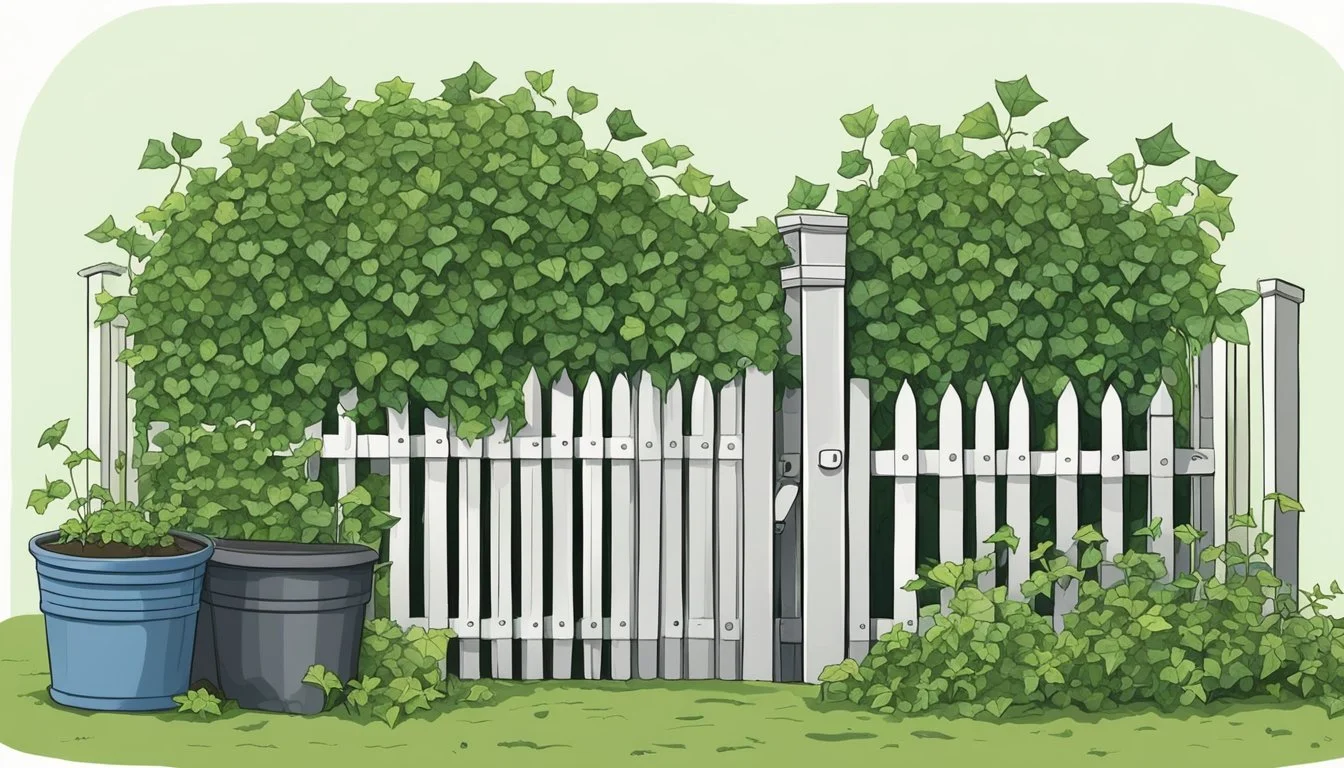Can You Compost Ivy Clippings?
Understanding the Risks and Rewards
Composting ivy clippings is often a subject of debate among gardeners. While ivy is a robust and vigorous plant known for its quick growth and evergreen foliage, the question arises when it comes to its disposal: can these clippings be composted effectively? The answer is yes, ivy clippings can be composted, but they require careful handling to ensure that they do not take root and grow within the compost pile, which could potentially introduce ivy back into garden beds.
The key to composting ivy is to ensure that the clippings are thoroughly dried out before they are added to a compost bin or pile. This is because fresh ivy clippings, with their inherent rooting ability, might sprout and grow in the favorable conditions provided by a moist compost environment. Drying the clippings deprives them of the moisture they need to propagate, making them safer to mix into compost.
In a compost heap, ivy clippings contribute primarily as a green material, rich in nitrogen. Nitrogen is a crucial component in the composting process as it feeds the microorganisms that break down the pile into usable compost. However, gardeners must balance these green materials with browns - carbon-rich materials - to create an optimal environment for decomposition. When these conditions are met, ivy clippings can decompose without risk of propagating and can eventually be used to enrich garden beds as part of a nutrient-rich compost.
Understanding Composting Basics
Before diving into whether ivy clippings can be composted, it's crucial to understand the composting process, its benefits, and the key aspects it entails.
What is Composting?
Composting is the controlled breakdown of organic matter, such as leaves, vegetable scraps, and garden trimmings, through decomposition. The process is facilitated by microorganisms, including bacteria and fungi, which convert organic waste into a nutrient-rich material known as compost. This end product, often termed 'black gold,' is invaluable for improving soil health and fertility.
Benefits of Composting
Composting offers numerous benefits to both the gardener and the environment:
Soil Amendment: Compost enhances soil structure, moisture retention, and provides a slow-release of essential nutrients.
Waste Reduction: By composting, one significantly reduces the amount of organic waste sent to landfills.
Environmental Health: Compost use can aid in reducing the reliance on chemical fertilizers, promoting a healthier ecosystem.
Composting Process Overview
The composting process involves four key components vital for effective decomposition:
Browns: These include dry materials like fallen leaves, branches, and cardboard, providing carbon.
Greens: These are wetter materials such as food scraps and grass clippings, contributing nitrogen.
Water: Maintaining adequate moisture is essential, as too little or too much can hinder the process.
Air: Turning the compost pile introduces oxygen, which is necessary for aerobic decomposition.
The ratio of greens to browns, the pile's moisture, and regular aeration are critical factors in ensuring a successful composting process.
Ivy Clippings in Composting
When incorporating ivy clippings into compost, one must consider their unique properties that affect the composting process. Ivy's growth habits and plant characteristics necessitate specific considerations to prevent issues such as regrowth within the compost pile.
Can You Compost Ivy Clippings?
Ivy clippings, while organic, are not as straightforward to compost as other plant matter. The primary concern is their proclivity for regrowth. Ivy, particularly English ivy, is known for its vigorous growth and can easily root and sprout new plants under favorable conditions. These characteristics mean ivy can survive and propagate even when added to compost heaps, possibly leading to an invasive species issue within the compost itself.
In the decomposition process, the robust nature of ivy with its waxy leaves and strong vines requires a longer timeframe to break down compared to softer, green plant materials. Therefore, thorough composting of ivy clippings is feasible but requires careful management to ensure full decomposition without regrowth.
Challenges with Ivy in Compost
Composting ivy presents a few significant challenges:
Regrowth Potential: Ivy's resilience means it can re-establish itself from clippings, becoming an invasive element within the compost pile.
Thick Coating: The leaves' waxy coating impedes the decomposition process, necessitating more time for the plant material to fully break down.
Invasive Species Risk: Particularly in the case of English ivy, an invasive species, improper composting might contribute to its spread, affecting local ecosystems.
To counteract these challenges, composters can take steps such as:
Hot Composting: Maintaining the compost at higher temperatures (above 145 degrees Fahrenheit) by turning the pile regularly. This helps to 'cook' the ivy, aiding in its breakdown and preventing regrowth.
Mature Composting: Ensuring ivy is only added to a mature or 'hot' compost which can handle its decomposition more effectively. Alternatively, ivy can be treated or dried out before being added to the pile to inhibit its growth capabilities.
By being aware of these considerations, ivy clippings can be managed within a compost system without undermining the process or local plant biodiversity.
Preparation of Ivy for Composting
When composting ivy, certain steps must be taken to prevent it from growing in the compost pile. Shredding ivy clippings and removing new growth are critical methods to ensure that ivy decomposes rather than taking root.
Shredding Ivy Clippings
Ivy clippings should be shredded before adding them to the compost pile. This aids in breaking down the thick, waxy coating that can hinder decomposition. Shredding can be done using:
Garden shredders: Electric shredders can efficiently fragment ivy into smaller pieces.
Manual cutting tools: If a shredder is not available, garden shears or scissors can also be used to cut the ivy into one to two-inch sections.
Shredded ivy exposes more surface area to microbes, which accelerates the composting process.
Pruning and Removing New Growth
To prevent ivy from regrowing in the compost, new growth should be pruned and discarded. Here's how:
Identify: Look for green and supple stems, which indicate new growth.
Prune: Using pruning shears, cleanly cut the new growth away from the older sections.
Dispose: It is advisable to dispose of the new growth separately, as these pieces have a higher chance of taking root.
Removing new growth is a critical step in ensuring that the ivy does not continue to grow within the compost pile.
Optimizing Composting Conditions
Optimizing composting conditions is crucial for breaking down materials like ivy clippings efficiently. Ivy is notoriously difficult to compost due to its vigorous growth; thus, maintaining the right balance of elements within the compost pile is essential.
Balancing Carbon and Nitrogen
For effective composting, the ratio of carbon-rich materials (browns) to nitrogen-rich materials (greens) should be roughly 30:1. Carbon provides energy, while nitrogen supplies proteins to the decomposing microbes. Here’s an ideal balance:
Browns: Dry leaves, branches, and paper
Greens: Kitchen scraps, lawn clippings, and ivy
Ivy should be added in moderation, ensuring it doesn't dominate the greens, and should be well-chopped to speed up decomposition.
Maintaining Adequate Moisture Levels
The moisture level of a compost pile should be similar to that of a wrung-out sponge. If the pile is too dry, microbial activity will slow down; if too wet, it can lead to anaerobic conditions and odors. Here are ways to maintain:
Add Water: Sprinkle water when dry.
Adjust Materials: Add dry browns or wet greens as necessary.
Ensuring Proper Aeration
Proper aeration prevents anaerobic conditions and helps control moisture. Aerating the pile by turning it regularly allows oxygen to reach the microbes that are actively working to decompose materials. Ivy clippings can become matted and impede airflow, so mix them with coarse materials like straw to enhance structure and aeration in the pile.
Benefits and Drawbacks of Ivy in Gardens
Ivy often garners mixed feelings from gardeners due to its dual nature as both a benefit in mulching and a challenge due to its potential risks, including toxicity.
Mulching with Ivy Clippings
When it comes to mulching, ivy clippings can be beneficial. Gardeners might use dried ivy as a mulch for garden beds because it can help retain soil moisture, suppress weeds, and provide a protective layer against temperature extremes. Properly composted ivy, devoid of living stems and roots, contributes organic matter to the soil as it decomposes, enhancing soil structure and fertility.
Potential Risks and Toxicity
However, there are notable drawbacks to consider. Ivy clippings may carry the risk of toxicity if the ivy is the variety known as Hedera helix, which contains compounds harmful to pets and humans upon ingestion. Furthermore, fresh ivy clippings are not recommended for direct use as mulch in gardens due to their invasive nature; they may root and propagate, dominating garden beds. When not fully killed, ivy can stifle the growth of other plants and negatively affect biodiversity within the garden ecosystem.
Alternative Disposal Methods for Ivy
While composting ivy can be challenging, due to its potential to reroot and spread, there are alternative disposal methods that significantly reduce the environmental impact and can even utilize the plant's characteristics beneficially in landscaping.
Green Waste and Environmental Impact
One responsible alternative is utilizing green waste collection services. Green waste programs are designed to handle yard debris separately from other waste, minimizing landfill use and reducing environmental impact. Gardeners should ensure ivy clippings are thoroughly dried before adding them to green waste bins to prevent any rerooting. Some municipalities have specialized facilities where green waste is processed at high temperatures, effectively killing any seeds or sections of ivy that might otherwise propagate.
Other Uses of Ivy in Landscaping
Ivy clippings, once properly treated to prevent growth, may also be repurposed in landscaping:
Mulch: Dried ivy can serve as a natural ground cover, reducing weed growth and helping to maintain soil moisture.
Erosion Control: On slopes or areas prone to erosion, layers of dried ivy may help to stabilize soil.
Wildlife Habitats: Dense ivy can also be arranged to create shelters for small wildlife, contributing to a diverse ecosystem when carefully managed.
Ivy should never be disposed of in natural areas, as it can become invasive and outcompete native plants. Gardeners should exercise caution and consider using ivy purposefully and sustainably.
Advanced Composting Techniques
In advanced composting techniques, understanding the specifics of the materials being composted is crucial. Different items require different approaches to effectively break down in a compost heap. Ivy clippings, particularly woody ones, present a unique challenge that can be managed through tailored methods like hot composting and specific treatment of woody material.
Hot Composting Method
Hot composting is an accelerated technique that relies on maintaining high temperatures to hasten decomposition. Best practices in hot composting involve:
Balanced 'Greens' and 'Browns': A mix of nitrogen-rich green materials and carbon-heavy brown materials.
Adequate Moisture: The pile should be as wet as a wrung-out sponge.
Frequent Turning: This encourages oxygen flow and evenly distributes heat.
Table 1: Hot Composting Ratios
Material Type Ratio Green Materials (e.g., grass clippings) ~1 part Brown Materials (e.g., dry leaves) ~2 parts
Hot composting can effectively break down ivy clippings, particularly when they are finely chopped and mixed well with other materials.
Composting Woody Ivy Material
For woody ivy material, specific measures are necessary to ensure successful composting:
Shredding or Chopping: Woody ivy should be shredded or chopped into small pieces to increase surface area.
List of Steps for Composting Woody Ivy:
Shred the ivy clippings using a garden shredder or similar tool.
Add to the compost heap, ensuring a proper balance of green and brown materials.
Maintain the heap with regular turning and moisture control.
The composting of woody material typically takes longer, but with vigilant best practices, such as chopping it to increase surface area and blending it with high-nitrogen materials, the woody ivy will decompose effectively within the heap.
Compost Application in Gardening
Compost serves as a key component in establishing a healthy garden by providing nutrient-rich soil amendments that encourage robust plant growth.
Enriching Soil with Compost
Incorporating compost into garden soil is a central part of improving its quality. Compost adds vital nutrients and organic matter that can help to transform poor soil into a fertile medium. To enrich soil with compost, gardeners should evenly distribute a 2-3 inch layer of compost over the garden bed and then till it into the top 6-8 inches of soil. This process augments the soil structure, enhances its water retention capacity, and inoculates it with beneficial microorganisms.
Benefits of using compost in soil enrichment:
Increases organic content of the soil
Boosts soil structure and aeration
Enhances the soil's water-holding capacity
Supplies a slow release of essential nutrients
Using Compost for Edible Plants and Crops
When tending to edible plants and crops, the use of compost is especially beneficial. Compost can be used as a top dressing or mixed into the planting holes for new vegetables and fruits. By doing so, it provides a continuous stream of nutrients throughout the growing season. Gardeners can apply compost to their edible gardens a few weeks before planting to allow the nutrients to permeate the soil and become readily available to the plant roots.
For maintaining nutrient-rich soil for crops, a guideline is to add up to 25% compost by volume when filling raised beds or planting areas. It's crucial to ensure that the compost is well-aged and fully decomposed to prevent any potential harm to the plants due to unfinished decomposition processes.
Key steps in using compost for edible gardens:
Apply compost before planting to condition the soil
Mix compost into the soil at planting time
Utilize compost as a top dressing to nourish plants throughout the season
By following these guidelines for compost application in gardening, gardeners can promote healthy soil ecosystems and vigorous plant growth, laying the foundation for a productive garden.
Maintaining a Healthy Compost Pile
A healthy compost pile requires a balance of nitrogen-rich and carbon-rich materials, combined with proper management practices to prevent common issues and deter pests.
Common Composting Problems and Solutions
Imbalance of Materials: A compost pile should maintain a carbon to nitrogen (C) ratio between 30:1 and 15:1. Problems often arise when there is too much of either component. To correct an excess of nitrogen-rich materials (such as kitchen scraps and grass clippings), one should add carbon-rich materials like dry leaves or shredded cardboard. Conversely, if the heap is too carbon-heavy, adding more nitrogen-rich materials will help rectify the imbalance.
Excess Moisture: Compost that is too wet can lead to a slimy, smelly pile.
Solution: Add dry, brown materials and turn the pile to increase airflow.
Lack of Decomposition: If compost is not breaking down, it could be due to inadequate moisture or insufficient nitrogen.
Solution: Moisten the pile and mix in nitrogen-rich materials.
Temperature Regulation: The compost pile should reach temperatures between 131°F and 170°F to promote decomposition and kill pathogens. A thermometer can monitor the temperature, and turning the pile will help distribute heat evenly.
Pest Control in Compost Heaps
Physical Barriers: Enclose the compost pile with a pest-resistant container or mesh to prevent access. Proper aeration and maintaining the right moisture level can also create an environment less attractive to pests.
Proper Material Management: Do not add meat, dairy, or oily foods to compost, as these can attract pests. Instead, focus on plant-based kitchen scraps, yard waste, and appropriate green materials.
Regular Maintenance: Turn the pile regularly to bury new additions and disrupt pests.
Creating Layers: Alternate layers of green (nitrogen-rich) and brown (carbon-rich) materials to discourage pests and promote nutrient-rich compost production.







